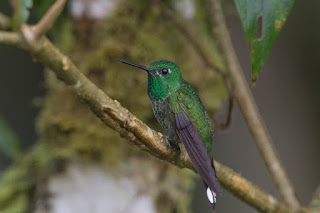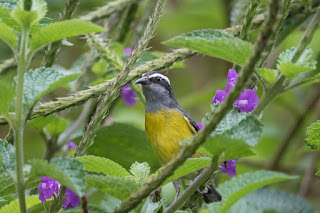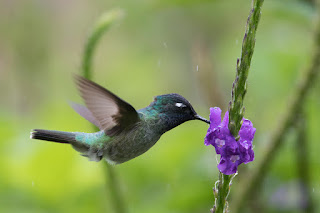San Isidro
(continued)
Just about the same as before, except for one invertebrate.
Powerful Woodpecker
Green Jay
Pale-edged Flycatcher
Rothschildia aricia
This moth is the biggest one we had the whole trip. It even caught the attention of a few people who usually only care about birds. I would think that a moth this size is an easy target and meal for all of the birds foraging around, but I was wrong. It was still doing pretty good 3 hours after I moved it from the ground to this tree. Either the fake eyes on the wings worked or its camouflage worked or the birds are not interested in it.WildSumaco Lodge
Some of the hummingbirds here are just stunning, possibly because we missed out on the previous days. We are familiar with a few species by now, but some are very different.
Brown Violetear
Not too fancy, but has shiny throat and face.
Sparkling Violetear
seen at almost every place we've been to.
Booted Raquettail
The Eastern slope subspecies has orange puffs around their legs. Ones found on Western slope have white puffs.
Green Hermit
Golden-tailed Sapphire
male
female
Black-throated Brilliant
Rufous-bibbed Whitetip
Many-spotted Hummingbird
Violet-headed Hummingbird
Wire-crested Thorntail
Female WCTH looks similar to female Green Thorntail
Bananaquit
cool name!
Black-mandibled Toucan(Yellow-throated)
Regular visitors to the trees right outside the dining area.
Looks the similar to Choco Toucan, but the lower mandible is more strait.
Golden-collared Toucanet
These are some of my favorite birds of the whole trip.
Gilded Barbet
male
female
Paradise Tanager
Sep 6
WildSumaco
Still lots of hummers
Brown Violetear
Booted Raquettail
Violet-headed Hummingbird
Wire-crested Thorntail
Gould's Jewelfront
Regular profile
Puffed up version
Black-throated Brilliant
Fork-tailed Woodnymph
Napo Sabrewing
the feathers are light. this bird has its own light sabres.
Ecuadorian Piedtail
White-tipped Sicklebill
This bird certainly is not abundant around the lodges and has specific food sources. I did not want to spend too much time waiting for it so I did not see it. My dad and Liu and a few others however sat beside the Heliconia plants for more than 5 hours without photographing other birds and got quick looks of its deeply curved bill.
In South American rainforests, small birds often form mixed flocks and move together, even though they have different diets and niches on the food web. Some would stay in the canopies others move lower in the trees. I was able to photograph 7 species in this mixed flock and there were probably more that did not jump in front of me.
Palm Tanager
Golden-eared Tanager
Beryl-spangled Tanager
Blue-browed Tanager
Golden-collared Honeycreeper
male
female
I don't know this one
Golden-tufted Woodpecker
The golden-tufted lagged behind and formed their own group of about 15 birds.
A few birds also soar overhead when the sun came out.
Chestnut-collared Swift
Turkey Vulture
one of the few species I know from Canada
Swallow-tailed Kite
The only raptor species I managed to snap a few photos during the 2 weeks.
They also have a feeding area not far from the lodges where ground dwelling can be viewed in relatively close range. About 5 species can show up, 2 are easier to take photos of.
White-necked Thrush
Ochre-breasted Antpitta
because this species constantly moved its rump side to side so the locals nicknamed it ''Shakira'' after a female Colombian singer and dancer.
Back at the lodges, some non feathered friends can also be seen.
Napo Tamarin
Many moths, just to show a few.
I think this looks like Boba Fett's helmet from Star Wars.
And some other cool looking insects.








































































No comments:
Post a Comment